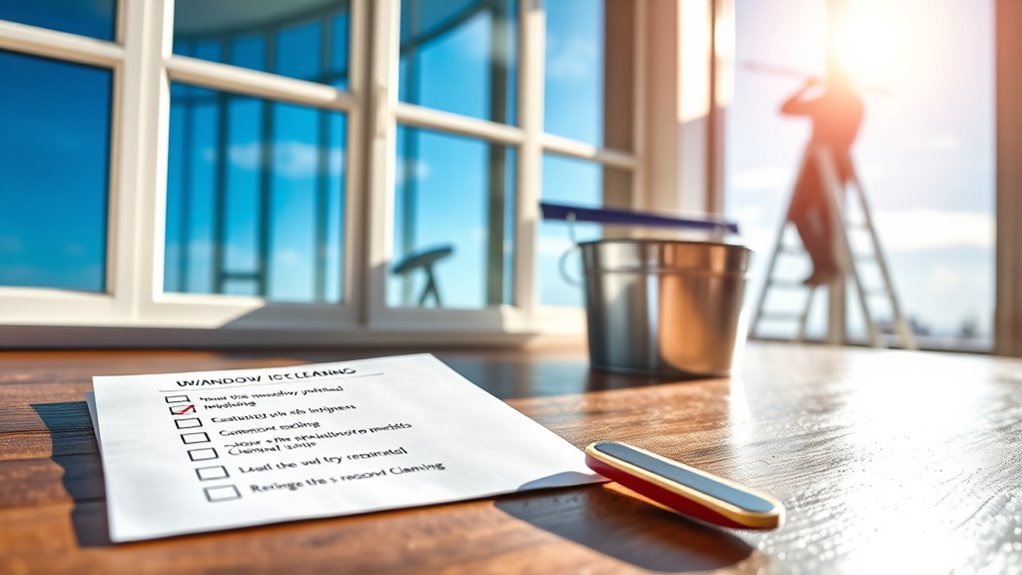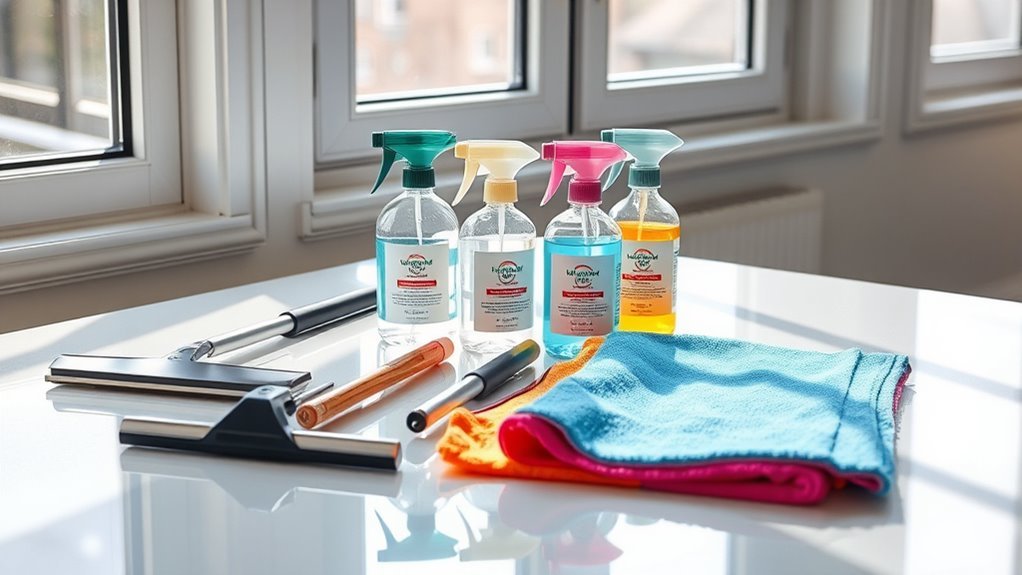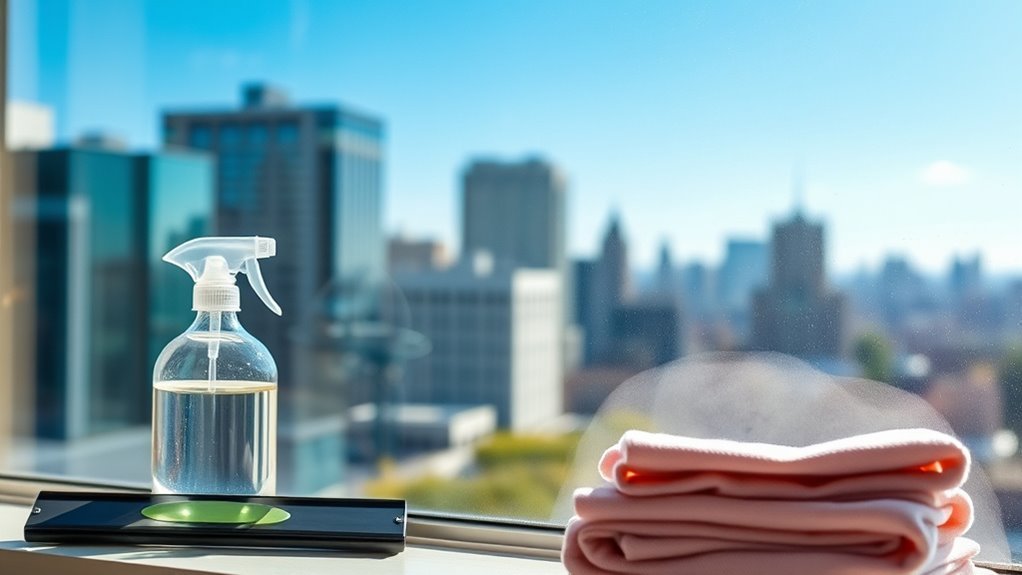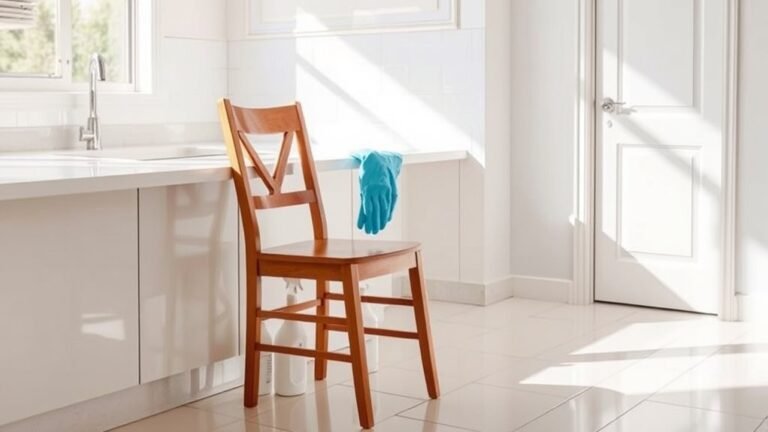Cleaning Checklist for Window Businesses
To run an efficient window cleaning business, start by preparing your worksite and inspecting tools for damage. Prioritize safety with gloves, goggles, and fall protection when needed. Clean exterior and interior windows using appropriate solutions, squeegees, and microfiber cloths for streak-free results. Dry windows carefully, avoiding direct sunlight to prevent smudges. Always inspect work from multiple angles for missed spots, and keep clients informed with clear communication. If you want streamlined processes and satisfied customers, there’s more to explore on setting up an effective checklist.
Preparing the Worksite and Equipment

Before you begin any window cleaning job, preparing the worksite and equipment is essential to assure efficiency and safety. Start by organizing the worksite: clear the area of obstacles, secure ladders or scaffolding, and guarantee easy access to windows. This setup minimizes interruptions and keeps you moving smoothly. Next, focus on equipment preparation. Inspect your squeegees, scrubbers, and cloths for wear, replacing any damaged tools to maintain quality results. Fill your buckets with the proper cleaning solution and have spare supplies ready. Check that your harnesses or belts are ready if working at heights. By prioritizing worksite organization and thorough equipment preparation, you’ll reduce downtime and increase your productivity, giving you the freedom to complete jobs confidently and on schedule. Additionally, always ensure to wear protective gloves and a mask to shield against dust and maintain safety during cleaning tasks.
Safety Measures and Precautions
While working on window cleaning projects, prioritizing safety measures and precautions is essential to protect yourself and others around you. First, always wear appropriate safety gear—gloves, goggles, and non-slip shoes—to minimize injury risk. Verify proper fall protection by using harnesses or guardrails when working at heights. Familiarize yourself with emergency procedures, including first aid and evacuation routes, so you can respond quickly if accidents occur. When it comes to chemical handling, read labels carefully, use only recommended amounts, and store products securely to avoid spills or harmful reactions. By consistently following these safety practices, you maintain a secure work environment that supports your freedom to work confidently and efficiently without unnecessary risks slowing you down. Additionally, choosing non-abrasive cleaners helps prevent damage to surfaces and ensures safe handling during cleaning.
Exterior Window Cleaning Steps

Start by removing loose dirt and debris from the window surface using a soft brush or a dry cloth. This initial step prevents scratching during cleaning. Next, choose your cleaning solution wisely; comparing techniques helps you pick the most effective one for different window types. Don’t forget to evaluate equipment upgrades that can improve efficiency and safety, like water-fed poles or squeegees with ergonomic handles.
Begin by clearing dirt with a soft brush, then select the best cleaning solution and upgrade your tools for safety and efficiency.
- Apply cleaning solution evenly, avoiding streaks.
- Use a squeegee with smooth, consistent strokes from top to bottom.
- Wipe edges and sills to catch drips and prevent residue buildup.
Always test cleaning products on a small, hidden area first to ensure they are safe for the surface type.
Interior Window Cleaning Procedures
Focus on creating a clean, streak-free finish by preparing the interior window surface carefully. Start by dusting frames and sills to avoid dirt mixing with moisture. Tailor your interior techniques based on glass types—some require gentler handling to prevent damage. Use a consistent, circular motion to loosen grime, then wipe in vertical strokes for clarity. Always dry thoroughly to avoid streaks. Managing humidity levels during cleaning can help prevent mold growth and maintain the integrity of window frames.
| Step | Technique | Glass Type |
|---|---|---|
| Dust frames | Soft brush | Standard |
| Clean glass | Circular motion | Tempered, laminated |
| Dry surface | Vertical strokes | All types |
Mastering these steps guarantees your clients enjoy spotless windows and the freedom of view they deserve.
Tools and Cleaning Solutions Checklist

To achieve the spotless results outlined in interior window cleaning, having the right tools and cleaning solutions at hand makes all the difference. You want to equip yourself with reliable window tools and effective cleaning supplies that boost your efficiency and free up your time. Here’s a practical checklist to keep you organized:
- Squeegees and Scrapers: Essential for streak-free glass and removing stubborn grime without damage.
- Microfiber Cloths: Perfect for wiping edges and polishing without leaving lint behind.
- Professional Cleaning Solutions: Choose streak-free, non-toxic formulas designed specifically for glass to enhance clarity and protect surfaces.
- Regularly vacuum nearby curtains and window tracks to reduce airborne allergens and improve overall cleaning effectiveness, as recommended in Cleaning and Dusting Windowsills.
Handling Different Types of Windows
When you’re cleaning windows, understanding the type of window you’re dealing with is essential for choosing the right approach and tools. Different window types—like double-hung, casement, sliding, or stained glass—each demand specialized techniques to avoid damage and guarantee a thorough clean. For instance, double-hung windows benefit from squeegees, while casements might require gentle wiping to protect hardware. Stained glass needs non-abrasive cleaners to preserve its finish. You’ll want to assess the frame material, too, since wood, aluminum, and vinyl call for different care methods. By tailoring your cleaning strategy to the specific window types, you’ll work more efficiently and deliver superior results. This attention to detail not only safeguards the windows but also boosts your reputation for professionalism and freedom in your work.
Streak-Free Drying Techniques
To achieve streak-free drying, you’ll need to choose the right cloth—microfiber is often best for absorbing moisture without leaving fibers behind. Use consistent, gentle motions like horizontal or vertical strokes to prevent smudges. Also, consider environmental factors such as direct sunlight or wind, which can cause drying too quickly and leave streaks. Working from top to bottom is recommended to prevent drips and ensure a streak-free finish.
Optimal Cloth Choices
Choosing the right cloth can make all the difference in achieving streak-free windows. When you pick your drying tools, focus on materials that won’t leave fibers behind or cause smudges. Microfiber cloths and lint free towels are your best bets—they absorb moisture effectively and prevent streaks.
Here’s what to look for:
- Microfiber cloths: Soft, durable, and highly absorbent, they trap dirt and moisture without scratching glass.
- Lint free towels: Designed to eliminate fibers, these towels help maintain a clear, spotless finish.
- Reusability: Choose cloths that can be washed and reused without losing effectiveness to save money and reduce waste.
Proper Drying Motions
Master proper drying motions to guarantee your windows come out crystal clear and streak-free. Start by using a clean, lint-free cloth, applying consistent pressure as you move across the glass. Employ horizontal strokes on one side and vertical strokes on the other to easily spot any missed spots. Avoid circular motions, which can leave streaks and smudges. Work swiftly but methodically to prevent water from drying and leaving marks. For best results, dry windows when they’re shaded from direct sunlight. Incorporating these proper drying techniques guarantees a polished finish without residue. Remember, your drying motions directly impact the final look—steady, deliberate strokes free of excess pressure let you achieve a flawless, streak-free shine every time.
Environmental Factors Impact
While perfect drying motions set the foundation for streak-free windows, the environment around you plays a significant role in the outcome. Weather conditions like direct sunlight or high temperatures can cause the cleaning solution to dry too quickly, leaving streaks. Similarly, poor air quality with dust or pollen can settle on wet surfaces, ruining your efforts. To guarantee the best results, keep these factors in mind:
- Choose mild weather days, avoiding extreme heat or wind.
- Monitor air quality reports and schedule cleaning when pollution or allergens are low.
- Work in shaded areas to control drying speed and prevent premature evaporation.
Post-Cleaning Inspection and Touch-Ups
After finishing the cleaning process, you’ll want to carefully inspect every window for streaks, smudges, or spots you might have missed. Conduct a thorough post cleaning assessment by examining windows from different angles and lighting conditions. Use a clean, dry microfiber cloth to address any remaining imperfections immediately. This final quality check confirms your work meets high standards and leaves clients satisfied. Be systematic—start from one side and move consistently to the other to avoid overlooking areas. Touch-ups should be swift and precise, maintaining efficiency without sacrificing quality. By mastering this step, you not only guarantee pristine results but also reinforce your commitment to excellence, giving you the freedom to grow your business with confidence and trust.
Client Communication and Feedback Collection
You’ll want to establish clear communication channels to keep clients informed throughout the cleaning process. Asking targeted questions after service helps you gather valuable insights on their satisfaction and any concerns. This feedback lets you improve your service and build stronger client relationships. Additionally, maintaining a daily disinfection schedule ensures consistent cleanliness and safety, which can be communicated to clients to reinforce trust.
Effective Communication Strategies
When reaching out to clients, clear and consistent communication sets the foundation for trust and satisfaction. To enhance client engagement, you’ll want to use effective communication tools that keep interactions smooth and professional. Focus on being responsive and transparent to build lasting relationships that support your business growth. Here are key strategies to help you communicate effectively:
- Use multiple communication tools like emails, texts, and phone calls to meet client preferences.
- Schedule regular updates and check-ins to keep clients informed about service progress.
- Encourage open dialogue by asking clear questions and inviting feedback after each job.
Gathering Client Insights
Building on clear communication, gathering client insights helps you understand their needs and improve your window cleaning services. Start by identifying effective feedback methods that suit your clients, such as short surveys, follow-up emails, or quick phone calls. Focus on capturing client preferences, including their preferred cleaning times, frequency, and specific concerns. Organize this information systematically to tailor your services efficiently. Encourage honest feedback by making the process simple and stress-free, respecting your clients’ time and freedom. Regularly review the collected data to spot trends and adjust your approach accordingly. By consistently gathering and analyzing client insights, you’ll enhance satisfaction, build trust, and create a flexible service that aligns precisely with what your clients want. This proactive approach keeps your business responsive and client-focused.
Scheduling and Maintenance Recommendations
Although maintaining clean windows is essential for a professional appearance, establishing a consistent cleaning schedule tailored to your business’s specific needs is equally important. You want scheduling flexibility to accommodate varying client demands and weather conditions while ensuring maintenance frequency prevents dirt buildup and extends window lifespan. Consider these recommendations:
Consistency and flexibility in window cleaning schedules are key to maintaining a professional look and prolonging window life.
- Assess each client’s environment and adjust maintenance frequency accordingly.
- Build in buffer days to handle unexpected delays or rescheduling.
- Use digital tools to create and track flexible schedules effortlessly.
- Regularly monitor cleaning effectiveness to ensure your window maintenance meets business needs and adjust as necessary.
Frequently Asked Questions
How Do Weather Conditions Affect Window Cleaning Schedules?
Think of weather as the unpredictable artist painting your cleaning schedule. You’ll need seasonal adjustments since icy winters and scorching summers can delay or accelerate your plans. Temperature impacts how quickly cleaning solutions dry—too hot, and streaks appear; too cold, and water freezes. By staying flexible and watching forecasts, you can keep your windows spotless without feeling chained to a rigid timetable, giving you the freedom to work smarter, not harder.
What Insurance Is Recommended for Window Cleaning Businesses?
When running your window cleaning business, you’ll want liability insurance to protect yourself from accidents or property damage claims. This coverage is essential because it shields your assets and keeps your freedom intact, letting you focus on growing your business without constant worry. Additionally, consider extensive business coverage that includes equipment protection and worker’s compensation if you have employees. These insurances create a safety net, so you’re prepared for unexpected situations.
How Can Window Businesses Market Their Services Effectively?
Wondering how to stand out in a crowded market? Start by harnessing social media to showcase your work and engage potential clients. Share vibrant photos and videos of spotless windows, and don’t underestimate the power of customer testimonials—they build trust and credibility fast. Stay consistent, respond promptly, and highlight what makes your service unique. With a strategic, organized approach, you’ll attract freedom-loving customers who value quality and reliability.
What Are Common Pricing Models for Window Cleaning Services?
When setting your pricing strategies, you’ll often see window cleaning services use per-window, hourly, or flat-rate models. Offering service packages can attract clients seeking convenience and savings, like basic, premium, or recurring cleaning plans. You want to be clear and flexible, giving customers freedom to choose what fits their needs and budget. Practical, transparent pricing builds trust and helps you stand out in a competitive market.
How to Train New Employees in Window Cleaning Techniques?
Training new employees in window cleaning is like teaching someone to ride a bike—you start with basics, ensuring they understand safety protocols thoroughly. You’ll want to demonstrate techniques step-by-step, emphasizing proper tool use and ladder safety. Encourage them to gather customer feedback after jobs to refine their skills and build confidence. Keep the training practical and clear, so they gain freedom to work independently while maintaining high-quality service.






